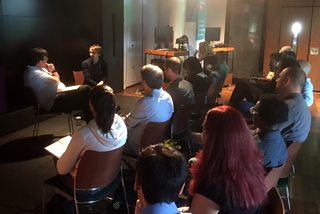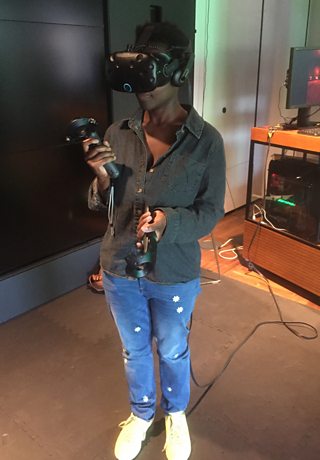Virtual Reality needs talented writers
Zillah Watson
Head of Content Commissioning, ±«Óãtv Virtual Reality
Tagged with:
What if virtual reality was more about writing craft than tech? VR offers writers undreamt-of possibilities. As puts it: "Think of the classic horror shot in cinema. You’re in the living room and you can’t see the monster coming from the hall. But in VR you can lean around the door and look in the hall."
Chelebourg was speaking at a ±«Óãtv Writersroom and writing workshop – an event held with the aim of introducing a new generation of talented writers to the challenges of writing for VR.

Mathias Chelebourg (front right) at the workshop for writing Virtual Reality
Virtual Reality is often portrayed in terms of technical advances. But to achieve its creative potential as a storytelling medium, it needs great writers too. ±«Óãtv television drama evolved in a similar way - from its earliest days with static cameras capturing theatrical productions to creating specially written television productions. Those came out of creative experimentation, using technological advancements that allowed ambitious shooting, cutting and mixing. VR can win huge audiences in the same way, by harnessing cutting-edge technology to the best storytelling.
Today, VR is still highly experimental and constantly evolving, but the technology is improving fast. VR is now ready for the creativity of writers who have learnt their craft in other worlds including theatre, film, TV, radio and games. For some genres, such as documentary, there is some understanding of how to create compelling VR content. But drama - and scripted drama in particular - needs more experimentation to redefine it for VR. This means making better use of techniques only possible in VR such as fully immersing viewers in other worlds which they can interact with.
And there’s much to experiment with because VR comes in many forms. The biggest distinction is between interactive (game-like) and non-interactive (film-like). Interactive VR is usually delivered in a game engine - a CGI world generated in real-time, which you can walk around and alter by your actions. Non-interactive is often live-action, filmed with 360 cameras, but can be a 'baked' CGI world, or animated/drawn, or any other visual style you might find in film. Scripted stories can be delivered with either approach.

Writers from the group had the opportunity to experience different kinds of storytelling in Virtual Reality
Although we are trying to provide writers with useful pointers to help them adapt their writing to the needs and possibilities of VR, Chelebourg was keen to stress that there are no rules and that experimentation is vital:
“VR is evolving. Keep watching VR. Keep trying experiments. If you think you can’t do something in VR, someone will be doing it and it will be working.”
Mathias Chelebourg, based in Paris, has worked in VR since 2012 and has written and directed a range of VR experiences including commercial work for brands. Recently he has created some high end drama experiences that merge immersive theatre with VR, such as - a virtual take on Alice in Wonderland where you become Alice and interact with characters played by actresses using live motion capture techniques.
For Chelebourg, VR does not change writing, rather it has added a series of new tools to staging and editing. That includes compelling interactions within a narrative. He uses a variety of scripting techniques for VR, from storyboarding with images for films, through to detailed scene by scene descriptions breaking down each moment into character, environment and interactions.
There were plenty of other perspectives too at the workshop. Game writer offered some important advice on a fundamental shift in thinking that writers need to make when approaching VR - and that involves focusing on the audience - and the active role they play in a VR experience. He says there is no such thing as a non-interactive VR experience.
“As players in VR we need to understand our role in the scene. We are more radically present in that scene then we are in any other type of media. We are participants in the simulation, never just spectators.”
Morgan stresses that to be successful, VR has to be a collaboration between player and story. Writers need to show the player where they stand in relation to the fourth wall and the characters. For this reason, VR is closer to theatre than to cinema.
”You have to build the space around the player. You have to create a space that ensures that wherever you’re looking they get it. And you have to work with the player to create that experience.”
A player can just be a ghost observing the scene – but their role needs to be consistent. And as long as you tell the player what they are then it works.
“All the conceit you need is: what object am I? It could be a toaster! As long as you tell the player.”
This is important for 360 video too, as well as for CGI-based interactive VR experiences.

Experiencing Virtual Reality at our writers' workshop, held at Digital Catapult's Immersive Lab
, the ±«Óãtv’s Africa Correspondent shared a tip his team used when filming the ±«Óãtv News VR documentary Damming the Nile.
Here the viewer travels with Alastair down the Nile, to discover the impact of a huge dam being built in Ethiopia.
Alastair’s production crew gave the 360 camera they used to shoot the film a name – Marvin – and even bought him a hat to keep him cool.
“Giving the camera a name was one of the best things we did. It gave him an identity and we started to relate to him as if he were there.”

Alastair Leithead in Khartoum with 'Marvin'
This meant that when they filmed a scene sitting around a table in an Ethiopian restaurant their first thought was where should Marvin sit? As a result, when the viewer puts the headset on to watch the film – they become Marvin and feel included in the experiences. Alastair even offers them a glass of water.
In the next few weeks we will blog again to explore in more detail some of the writers’ thoughts on how to approach writing for VR. Meanwhile here are some guiding principles from the ±«Óãtv’s VR Hub about how to get started.
VR Hub Tips on Writing for scripted VR drama
WHAT CAN VR OFFER DRAMA?
- VR can take you to places and provide experiences that are impossible or not advisable in real life.
- It delivers immersion - where the place is the story. Hard-to-visualise places are especially good, where VR can show the viewer a sense of scale and how things relate in a space.
- Presence: it can place you in the scene - helping you to feel present, and allowing you to emotionally engage directly with the characters and story in a way that’s unique to VR.
- Embodiment and interactivity - occupy new and impossible forms, using your new body to interact with the world and characters around you.
- Distraction-free, ‘enclosed’ viewing allows for potent creation of mood and atmosphere.
- Remember to ask: Why is this story best told in VR!?
DRAMA AND SCRIPTED STORYTELLING IN VR
- Think theatre - VR drama is closer to theatre than film. Sequences, cuts, and close-ups don’t drive the story. Scenes do. If you are faced with a challenge, thinking through how you might solve the problem in theatre will often lead to the solution.
- Who are you? Give the user a concrete presence in the scene. They could be a person, a fly on the wall, a prop, or even a camera (a ‘role’ users understand best from documentaries). Disembodied users feel less connected to your world. It is preferable to see this virtual ‘body’, but not always essential.
- Think ”Story-worlding” - create the rules for a story universe and then set your action within it.
- Attention - can only be steered, not forced. Spatial sound can help draw attention, as can lighting and movement cues, and scene/set design.
- Surround the viewer. Reward exploration of the scene. Make each viewer’s experience slightly different. There’s always somebody who will watch the back wall!
- Games Storytelling - Get familiar with video game narrative styles. A lot of VR storytelling challenges have already been solved by games.
Further Reading
- by Sam Saxton
- by Jesse Damiani & Dylan Southard
Some VR Experiences to try
